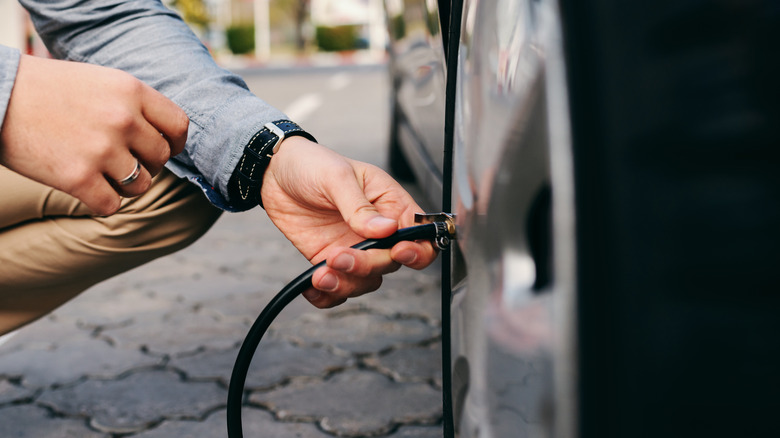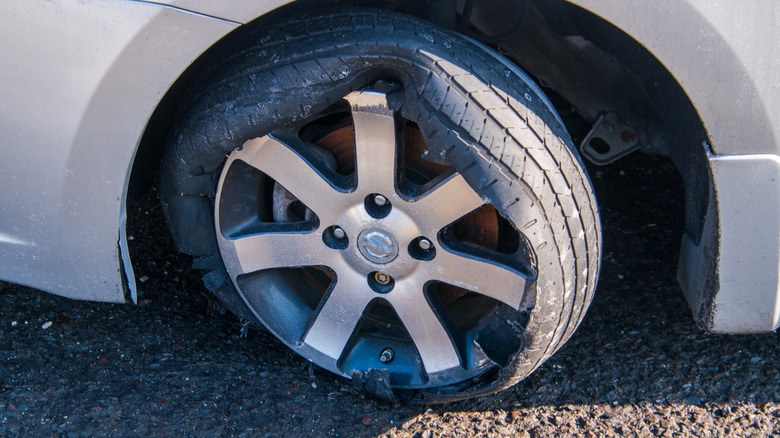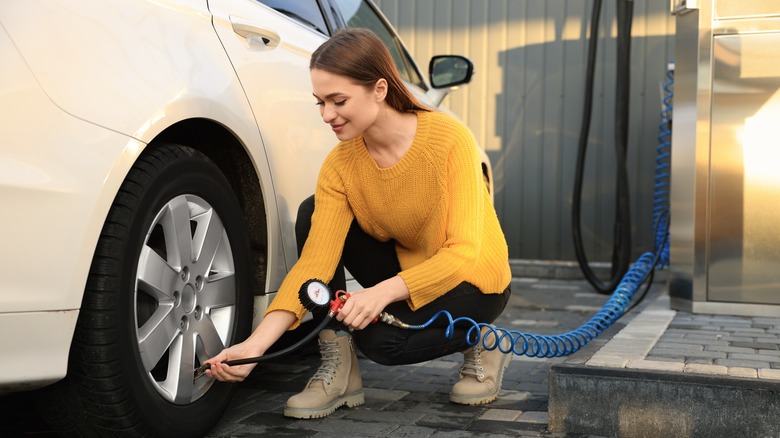What Happens If You Put Too Much Air Into A Car Tire?
Even the most vigilant people can easily slip up when it comes to automotive maintenance, a critical yet sometimes neglected aspect of vehicle care. No matter how mundane the task, it is crucial to ensure that whatever job being done on a car, truck, or SUV is executed in the most effective manner possible. An excellent example would be the basic act of inflating tires, as it holds the potential for a simple but impactful mistake known as overinflation. Whether due to a faulty gauge, momentary distraction, or misunderstanding of the recommended pressure, making a bloated oversight with your tire is a surprisingly easy error that isn't going to just float or roll away on its own.
The subtle misstep may seem like it wouldn't be that big of a deal when traveling on the road, but it could very well prove to have a greater effect on the entire driving experience. Not only that, but putting too much air in your name-brand tires could also do significant damage, and worse, it could be an issue that affects more than just one part of the vehicle. But among the many concerns, one of the crucial things to take into consideration is the overall safety of the driver and passengers, as well as other drivers. In order to better understand the dilemma, here's what motorists should know about adding too much air to their tires.
The unavoidable risks of wear and tear
Overinflated tires can affect the performance and lifespan of a tire, but one of the primary issues is the unwanted arrival of premature wear and tear. When a tire has too much air, the vehicle's weight sits on the center of the tread, and this uneven distribution of pressure causes that part of the tire to wear quicker. Overinflation also results in a harder tire surface, which compromises its ability to grip the road effectively. This reduced traction can be particularly noticeable in sharp turns or during quick stops, where optimal grip is crucial for vehicle control.
The wear and tear of an overinflated tire increases the risks of experiencing punctures and blowouts. The excess pressure within the tire puts additional stress on its structure, making it more vulnerable to damage from road hazards like sharp nails or, even worse, potholes. Another very significant safety issue arises when rain or snow are a factor. Tires are designed with treads to disperse water and prevent hydroplaning, but overinflation and reduced traction dangerously limit the contact area with the road surface, increasing the chances of losing control in wet conditions, as they are less effective at channeling water away and maintaining a stable grasp on the pavement. Not only will the price of too much air cost consumers a trip to the store to have the battered tires replaced, but it also has the potential to put the automobile and everyone involved at risk.
It could cost consumers more for than just a new tire
Overinflation can pose more than just a risk of needing to buy new tires. When they are inflated to excess, tires are unable to effectively absorb shocks from the road, causing additional stress on the suspension system over time, with the increased pressure potentially headed toward unsettling levels of deterioration. The lack of flexibility that a tire experiences when it's filled too much also makes it less capable of absorbing impacts from bumps or other obstructions in the road. So, the force and pressure from the hard-hitting streets and terrain is therefore transferred directly to the wheel with little help from the tire, allowing for dents or cracks that require expensive wheel replacements.
Paying to fix or replace parts that have taken damage from the over-inflated tires isn't the only thing drivers will have to shell out hard-earned cash for if they aren't careful, as the automobile's fuel efficiency could also be affected. When tires are not at their optimal inflation level, it forces the engine to work harder to move the car. The increased strain results in more frequent trips to the gas station and a heavier financial burden on the vehicle owner. Therefore, maintaining proper tire pressure is not only essential for safety but also for preserving the overall health and cost-effectiveness of a person's ride.
Ways to prevent putting too much air in tires
Fortunately, there are ways to stop overinflated tires from becoming a problem for vehicle owners. To avoid the risks, drivers must maintain the correct tire pressure. One of the most effective ways to accomplish this is by using a tire pressure gauge. This handy tool gives accurate readings, enabling consumers to inflate tires to the manufacturer's recommended PSI.
It is also advisable to inflate tires gradually, checking the pressure frequently to avoid going over the recommended level. For added precision in this matter, use an air compressor with a pressure regulator, as this device allows users to set the desired PSI and automatically stops inflation at the correct level, minimizing the risk of overdoing it with air. Always refer to the vehicle's manual or the information placard on the driver's side door jamb for the correct tire-related specifications for the automobile, and if at any point things seem confusing or some professional help is needed, it's never a bad idea to seek help from a trained mechanic or tire technician to ensure proper inflation takes place.
There is obviously a lot to remember when it comes to properly inflating one's tires, and it may be a bit overwhelming at first for some, but taking the extra effort to ensure that extra air doesn't force things to spin out of control will be well worth it.



